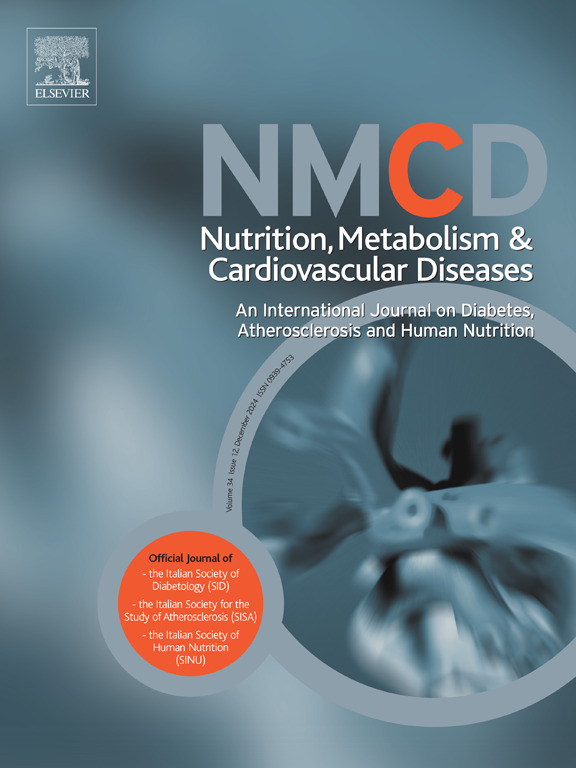Lipid profiles and their association with incident carotid atherosclerosis: A community-based prospective study in Taiwan
IF 3.3
3区 医学
Q2 CARDIAC & CARDIOVASCULAR SYSTEMS
Nutrition Metabolism and Cardiovascular Diseases
Pub Date : 2025-03-21
DOI:10.1016/j.numecd.2025.104023
引用次数: 0
Abstract
Background and aims
Dyslipidemia, characterized by abnormal blood lipid levels, contributes to atherosclerosis, a condition involving arterial plaque buildup and cardiovascular events. While LDL-C and LDL-to-HDL-C ratios are established atherosclerosis predictors, the role of non-HDL-C is less explored.
Methods and results
A cohort of 1062 participants without carotid plaque at baseline was analyzed over a 4.0-year follow-up. Age-specific incidence rates were calculated, and baseline characteristics of those who developed plaques were compared using logistic regression and area under the ROC curve (AUROC) analysis to evaluate predictive models. Carotid plaques developed in 284 participants (87 males, 197 females). Incidence rates increased with age, reaching 41.2 % in females and 60.0 % in males aged 70–74 years. Participants with plaques were older (58.2 vs. 55.4 years, p < 0.0001), had higher BMI, blood pressure, and lipid markers, and were more likely to be male, hypertensive, or hyperlipidemic. Logistic regression identified age (OR 1.26 per 5 years), BMI (OR 1.23 per 5 kg/m2), LDL-C (OR 1.07 per 10 mg/dL), and LDL-to-HDL-C ratio (OR 1.41) as significant predictors, with HDL-C offering a protective effect. Models incorporating lipid ratios (non-HDL-to-HDL-C or LDL-to-HDL-C) showed similar predictive power (AUROC 0.636).
Conclusion
Carotid plaque progression correlates with age, male sex, elevated BMI, hypertension, and adverse lipid profiles. Lipid ratios and age are consistent predictors, with HDL-C demonstrating protective effects. Comparable AUROC values across models underscore the value of lipid ratios for assessing atherosclerosis risk.
血脂及其与颈动脉粥样硬化的关系:台湾一项社区前瞻性研究。
背景和目的:血脂异常,以血脂水平异常为特征,有助于动脉粥样硬化,这是一种涉及动脉斑块形成和心血管事件的疾病。虽然低密度脂蛋白- c和低密度脂蛋白-高密度脂蛋白- c比值是公认的动脉粥样硬化预测指标,但对非高密度脂蛋白- c的作用探索较少。方法和结果:对基线时无颈动脉斑块的1062名参与者进行了为期4年的随访分析。计算年龄特异性发病率,并使用logistic回归和ROC曲线下面积(AUROC)分析比较发生斑块的基线特征,以评估预测模型。284名参与者(87名男性,197名女性)出现颈动脉斑块。发病率随年龄增长而增加,70-74岁女性为41.2%,男性为60.0%。有斑块的参与者年龄较大(58.2岁vs. 55.4岁,p 2), LDL-C (OR 1.07 / 10mg /dL)和ldl -HDL-C比值(OR 1.41)是显著的预测因子,HDL-C具有保护作用。纳入脂质比率(非hdl -对hdl - c或ldl -对hdl - c)的模型显示出类似的预测能力(AUROC为0.636)。结论:颈动脉斑块进展与年龄、男性、BMI升高、高血压和不良血脂相关。脂质比率和年龄是一致的预测因子,HDL-C显示出保护作用。各模型间的AUROC值比较强调了脂质比率在评估动脉粥样硬化风险方面的价值。
本文章由计算机程序翻译,如有差异,请以英文原文为准。
求助全文
约1分钟内获得全文
求助全文
来源期刊
CiteScore
6.80
自引率
2.60%
发文量
332
审稿时长
57 days
期刊介绍:
Nutrition, Metabolism & Cardiovascular Diseases is a forum designed to focus on the powerful interplay between nutritional and metabolic alterations, and cardiovascular disorders. It aims to be a highly qualified tool to help refine strategies against the nutrition-related epidemics of metabolic and cardiovascular diseases. By presenting original clinical and experimental findings, it introduces readers and authors into a rapidly developing area of clinical and preventive medicine, including also vascular biology. Of particular concern are the origins, the mechanisms and the means to prevent and control diabetes, atherosclerosis, hypertension, and other nutrition-related diseases.

 求助内容:
求助内容: 应助结果提醒方式:
应助结果提醒方式:


